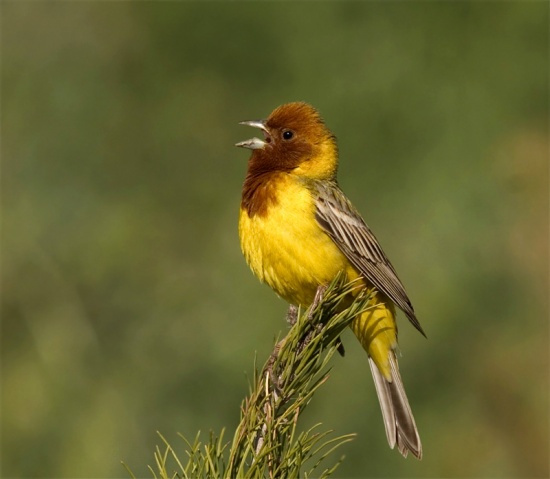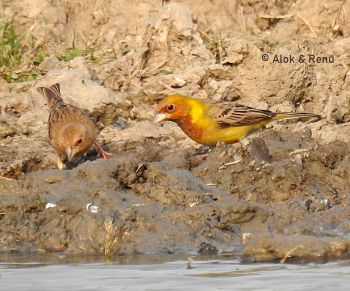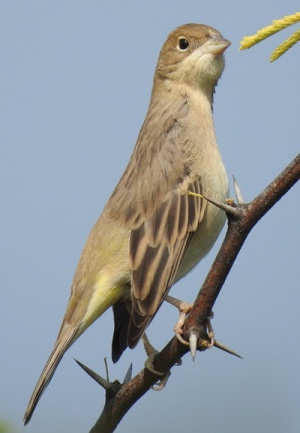m (→External Links: updated VSearch and GSearch) |
|||
| (11 intermediate revisions by 3 users not shown) | |||
| Line 1: | Line 1: | ||
| − | + | [[Image:158551104326-large.jpg|thumb|550px|right|Photo © by {{user|Seyed+Babak+Mus|Seyed Babak Mus}}<br />Sarakhs, north-east [[Iran]], April 2006]] | |
| − | [[Image: | ||
;[[:Category:Emberiza|Emberiza]] bruniceps | ;[[:Category:Emberiza|Emberiza]] bruniceps | ||
==Identification== | ==Identification== | ||
| − | + | 15–16·5 cm (6-6½ in); a largish bunting with a fairly long tail<br /> | |
| − | + | '''Breeding male''' | |
| − | + | *Bright yellow underparts | |
| + | *Green upperparts | ||
| + | *Brownish-red face and breast<br /> | ||
| + | '''Female''' overall paler than the male | ||
| + | [[Image:Red_headed_bunting_Alok.JPG|thumb|350px|right|Pair in spring passage<br />Photo © by {{user|aloktewari|Alok Tewari}}<br />Gurugram, Haryana, [[India]], 12 April 2021]] | ||
| + | *Paler underparts | ||
| + | *Greyish-brown back | ||
| + | *Grey head | ||
==Distribution== | ==Distribution== | ||
| − | [[ | + | South-central [[Eurasia]]; winters in the [[India]]n subcontinent. |
==Taxonomy== | ==Taxonomy== | ||
| + | This is a [[Dictionary_M-O#M|monotypic]] species<sup>[[#References|[1]]]</sup>. | ||
| + | |||
==Habitat== | ==Habitat== | ||
| − | Open | + | Open scrub, cultivated fields, countryside, grassland, desert, semi arid areas, woodlands and forest. |
==Behaviour== | ==Behaviour== | ||
| − | + | [[Image:RHBuntingFemShantilal.jpg|thumb|300px|right|Female<br />Photo © by {{user|Shantilal|Shantilal}}<br />Gujarat, [[India]], 8 December 2019]] | |
| + | ====Breeding==== | ||
| + | They make a nest in a tree or bush. The clutch consists of 3-5 eggs. | ||
| + | ====Diet==== | ||
| + | Their diet consists mostly of seeds, supplemented by insects during the breeding season. | ||
| + | ==References== | ||
| + | #{{Ref-Clements6thAug19}}#Handbook of the Birds of the World Alive (retrieved February 2016) | ||
| + | #BF Member observations | ||
| + | #Wikipedia | ||
| + | {{ref}} | ||
| + | ==External Links== | ||
| + | {{GSearch|"Emberiza bruniceps" {{!}} "Red-headed Bunting" -"melanocephala"}} | ||
| + | <br /> | ||
| + | {{VSearch|"Emberiza bruniceps" {{!}} "Red-headed Bunting" }} | ||
| + | {{GS-checked}}1 | ||
| + | <br /> | ||
| + | <br /> | ||
| − | + | [[Category:Birds]][[Category:Emberiza]][[Category:Videos]] | |
| − | |||
| − | |||
| − | [[Category:Birds]][[Category:Emberiza]] | ||
Latest revision as of 16:43, 10 May 2023
- Emberiza bruniceps
Identification
15–16·5 cm (6-6½ in); a largish bunting with a fairly long tail
Breeding male
- Bright yellow underparts
- Green upperparts
- Brownish-red face and breast
Female overall paler than the male
- Paler underparts
- Greyish-brown back
- Grey head
Distribution
South-central Eurasia; winters in the Indian subcontinent.
Taxonomy
This is a monotypic species[1].
Habitat
Open scrub, cultivated fields, countryside, grassland, desert, semi arid areas, woodlands and forest.
Behaviour
Breeding
They make a nest in a tree or bush. The clutch consists of 3-5 eggs.
Diet
Their diet consists mostly of seeds, supplemented by insects during the breeding season.
References
- Clements, J. F., T. S. Schulenberg, M. J. Iliff, S. M. Billerman, T. A. Fredericks, B. L. Sullivan, and C. L. Wood. 2019. The eBird/Clements Checklist of Birds of the World: v2019. Downloaded from http://www.birds.cornell.edu/clementschecklist/download/
- Handbook of the Birds of the World Alive (retrieved February 2016)
- BF Member observations
- Wikipedia
Recommended Citation
- BirdForum Opus contributors. (2025) Red-headed Bunting. In: BirdForum, the forum for wild birds and birding. Retrieved 26 April 2025 from https://www.birdforum.net/opus/Red-headed_Bunting
External Links
GSearch checked for 2020 platform.1






